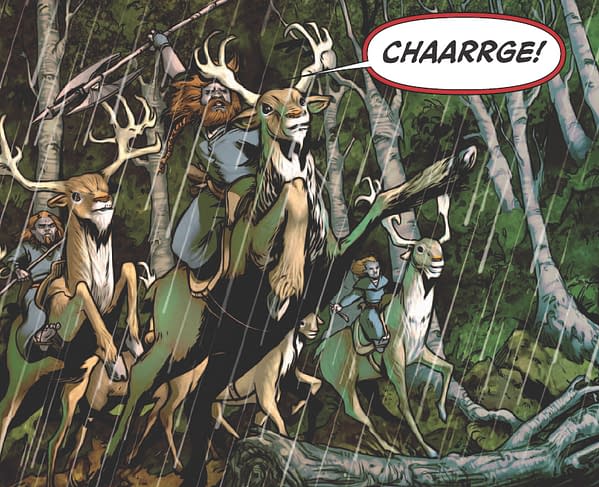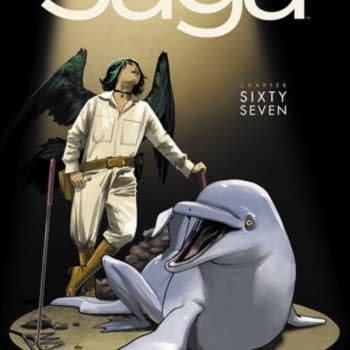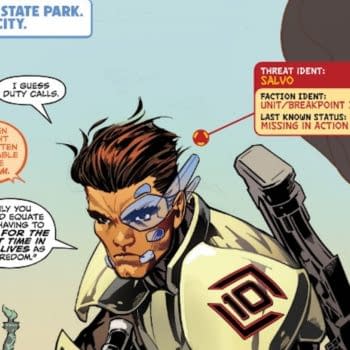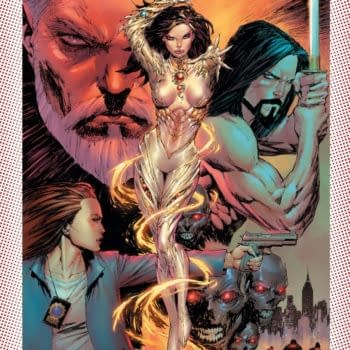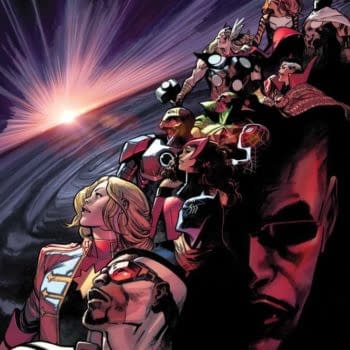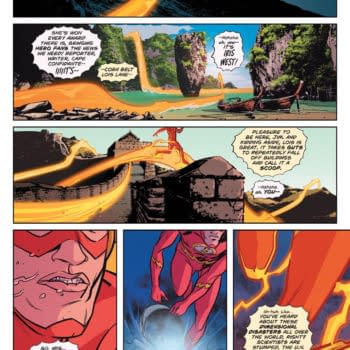Posted in: Comics | Tagged: aneke, Comics, damsels, dynamite, john reppion, leah moore
Damsels # 7 Charges Towards Arc's Finale
It's no secret that Dynamite Entertainment's series Damsels has been clever from its outset in 2012, taking the cloying appropriation of fairytale princesses in pop culture and children's literature not only back to its darker roots, but into dialogue with each other to create a complex new, but familiar, world. The comic has always been laced with inside jokes about literary tradition without being precious about them and thereby has preserved a sense of energy and discovery in readership. That freshness in writing and concept has been carefully balanced with a rebelliously appealing take on artwork, shuffling off the sentimental in favor of allure. It doesn't totally break with the traditions of fairytale illustrations that readers will associate with characters like Rapunzel and the Frog Prince, but it does relentlessly infuse static illustration with movement and physicality. In Damsels, the characters have always felt lifelike in a way that even film adaptations of fairy tales sometimes fail to achieve. That's due to the writing of duo Leah Moore and John Reppion, and the inventive artwork of Aneke.
Damsels is charging toward the completion of its first arc, and when issues 1-8 are in hand, they will be published as a collected volume, already available for pre-order. Issue #7 was released recently, and it's a notable comic due to the escalation of conflict, the intriguing meta-textual elements it increasingly reveals, and due to the successful introduction of new mysteries to set the stage for what's bound to be a remarkably frenetic final issue. Let's also add that in a series that prides itself on giving place to the darker aspects of fairy tales (and including the original inspirational versions of fairy tales in the back of each issue proves the point for Moore and Reppion), this issue is particularly disturbing in all the right ways. Firstly, it introduces an aspect of terror for the "children of earth" as the gathering creepiness of the witch-queens spills over into the dream-world earth children also inhabit. That it's simply stated as a fact, no dancing around the issue, that the two worlds are connected and that the fate of the world of Damsels is tied to the fate of the dream world of earth, proves that this comic thinks big and steadily builds a sense of significance in the events of its own storyline.
There's something inherently creepy about dopplegangers and doubles in stories anyway, but for doubles to fully replace their counterparts, including manipulating their spouses and loved ones is actually rather horrific. Issue #7 takes this to logical extremes as the "coven of witch queens" build their army to take on King Oberon of the fairies and his rallying subjects and show total control over the families of the "lost queens" they have replaced. We love our villainous witches in fairy tales, but it's a difficult subject to handle well. Like supervillains, they tend to make megalomaniacal pronouncements and shoot lightning at people or seduce them over to their cause. Moore, Reppion, and Aneke, address the subject in a fresh way by making their villainesses a confederacy like MacBeth's witches, and also by pitting them against what seems like an unlikely foe, the entire realm of fairy.
Even King Oberon explains grimly that they must be prepared to take lives in order to defend themselves from the approaching witch-armies, and it's spoken like a true pacifist. In no fairy tale is the fairy realm known for its orderliness or military strategy, and Oberon emphasizes this by naming in details all the various peoples he must call into his service. There's something comical, sympathetic, and even moving about the idea that "imps", "pixies", and even "gnomes" must take up arms, but there's nothing comical about their very serious application of their powers to the task. Issue #7 builds up the tension in these unconventional roles that is likely to be unleashed fully in #8.
There's something remarkably meaningful about Oberon's behavior in Issue #7, and that comes down to the haunting speeches he delivers that clarify and bring out more fully the underpinnings of the whole Damsels narrative so far. He speaks to the newly arrived "lost queens" and the Frog Prince in an omniscient way, talking about the "point in the story" that each have reached in their own, but combined, narratives. He knows, to some extent, their futures, as if they are set in stone, and reveals that they are all part of "one story", the "rules" of which cannot be broken. What he is speaking about, of course, are fairy tale archetypes and their continued power in storytelling. These are the same elements that continue to impact the children of earth in their dreams. This is very dangerous territory for a comic to tackle because it could easily come off as rather sappy, one character telling others that they are important because their stories are classic and part of the collective consciousness of humanity.
It could come off as a creative team patting themselves on the back and taking themselves far too seriously. But because Oberon is deadly serious and because he feels like a real character to readers, instead these pronouncements have implications for Oberon's own world as greatly as they might have meaning for the reader. In other words, it serves the story in a totally justified manner. The fact that Oberon reveals that he does not know everything, actually, helps tailor the message to the story further. This also assures that several mysteries are set up for reveal in Issue #8. The dramatic tension established throughout the series so far is maintained despite some of the reveals in #7 by a careful replacement of new, even more compelling and pointed questions.
It would be difficult to conceive of a comic achieving all of these things in a penultimate issue of its first arc without detailed, careful planning so a salute to Moore and Reppion is in order. The artwork in issue #7 is also particularly effective, packed with detail, and conveying action in its intercut scenes that doesn't break down into repetition. Visually, it feels like several full-length comic issues packed into one; Aneke clearly faced a difficult task in terms of layout and maintaining dynamism but rose to the occasion. Issue #7 of Damsels makes bold moves with great confidence and therefore carries them off with plenty of style, but it also adds to the mythology of the series in a solidly constructed way and knows just how to tweak the drama to a pitch that demands a big finale, one that the first arc richly deserves at this point.
Hannah Means-Shannon is a comics journalist and scholar working on books about Alan Moore and Neil Gaiman for Sequart.org. She is @HannahMenzies on Twitter and @hannahmenziesblog on WordPress.




